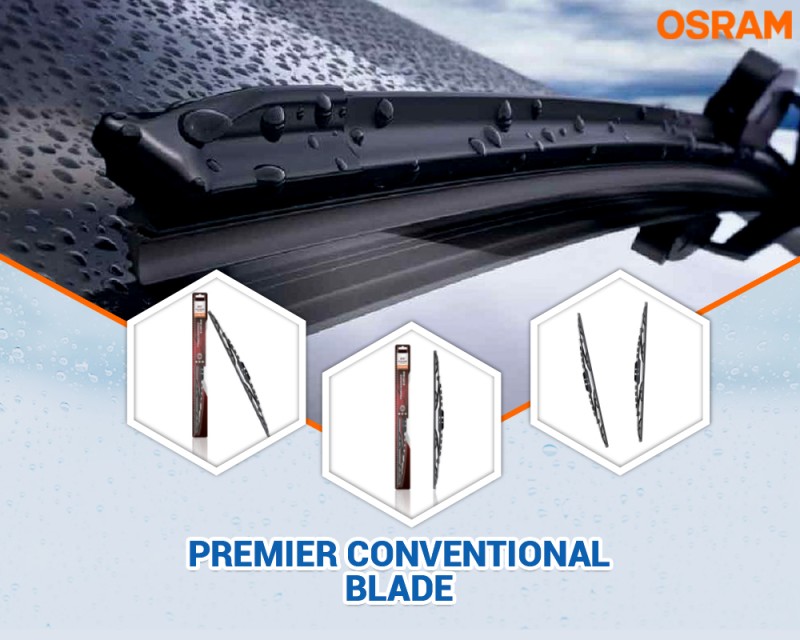Out of all the car accessories you might have thought of spending your money on, an OSRAM wiper is probably the last thing you might consider as a performance upgrade. After all, most people don’t even notice their wipers until they start making that horrible screeching noise, indicating that it is time for a replacement. Yet, when compared to a standard OEM car wiper, OSRAM probably offers the highest level of return on investment in terms of a wiper blade upgrade.

To understand how that can be, you need to understand what exactly wipers are, and how they function. This will give you an idea of how important it is to invest in a good wiper blade, and how the difference between a good or bad wiper blade can even mean the difference between life and death. So, let us first take a look at what exactly makes a car wiper.
What is a Car Wiper?
A traditional car wiper is an invention that came around the beginning of the 19th century, just as personal and commercial vehicles were starting to become a common sight on roads. As windshields became mandated by law, for safety purposes, so did these wipers, which were used to remove rain, snow, ice, washer fluid, or any other foreign debris from the windshield.
These wipers are connected to an electric motor in most modern cars, which help them move at variable speeds that can be set by the driver. Some vehicles also integrate heating lines and anti-freeze solutions to make visibility better in colder regions. Today, all sorts of motor vehicles, including but not limited to cars, trucks, buses, trains, boats with a cabin, and even aircrafts, are equipped with one or more wipers. With different models featuring different number of wipers, placed in different positions around the windshield, for optimal coverage.
Different parts of a Car Wiper
Most wipers consist of a rigid frame, which is covered by a soft rubber blade attached to the end of it. The frame is mounted on a metal arm, which is in turn connected to an electric motor, although some select models also feature pneumatic power for more force. The problem with this type of wiper blade is that once the rubber has been worn off, the entire frame has to be replaced, as you simply can’t replace the rubber part alone. Moreover, even if the rubber is partially worn off, any exposed bit of metal can end up scratching the surface of the windshield, which can in turn hamper visibility. especially in foggy conditions.
Some newer models bypass these issues, by skipping the metal frame and going straight for a full rubber blade, which offers more flexibility when it comes to wiping. This flexibility helps the blade adhere to all sorts of surfaces, so manufacturers have more options when it comes to curving their windshield, knowing the blade will adjust to the surface easily. This is an important trait to have in modern vehicles, which often feature more unconventional windshield designs that may even merge with the sunroof, like some Tesla models.
What makes an OSRAM wiper better?
The OSRAM wiper range features both types of wipers, each with its own unique benefits as compared to stock OEM options. However, since we are focusing on stock replacement wipers only, we will only talk about the Premier Conventional Blade wiper, which features a heavy-duty all-steel frame.
The advantage of having this frame is that it offers more durability in extreme weather conditions, when excess water weight, or some stick debris can end up hindering the path of traditional wiper blades. The metal frame also features a built-in multifunctional adapter, which allows it to fit in any number of cars. Even without the need for any additional tools to put it on, or take it off the vehicle. This means that you can use the same wiper blade on any number of car models, from different brands, and featuring different connecting points.
In addition to providing heft and durability to the wiper blade, the metal frame of the OSRAM wiper also features a unique aerodynamic design, which uses physical vents to create downforce, using the air that already smashes into the windshields. These vents are pretty small and blend in with the overall design of the blade, but offer an additional force multiplier, to ensure that the wiper sticks to the windshield, in even the worst weather conditions.
Another way that the company ensures a constant grip on the windshield, is by placing multiple pressure points across the wiper blade. These points are spaced out at equal distances, on either side of the blade, so there is no possibility of even a small portion of the blade lifting off the glass, when in operation. This goes a long way in ensuring full coverage when it comes to keeping the windshield clean.
The final bit of brilliance comes from the rubber blade itself, which features a special nanotech graphite coating. Which reduces the wear and tear on the blade, and ensures streak-free wiping in all sorts of weather conditions. By modifying the composition of the blade, the OSRAM wiper offers a longer lasting experience that is much smoother and scratch free than conventional blades, which often wear unevenly, thus resulting in more problems.
Just these handful of changes are enough to create a completely different user experience when it comes to using something as inconspicuous as a windshield wiper. While there may be a premium to be paid for getting these additional benefits, but in the end, you will end up making up for it, in terms of both the performance upgrade, as well as the additional longevity.
The best part is, choosing these blades over your stock ones will not affect your car’s warranty in any way, so you can even make this change in a brand-new car, to ensure a much smoother lifecycle for your car windshield. So, make sure you ask your personal mechanic about OSRAM wipers, if and when you decide to make the change.
.




